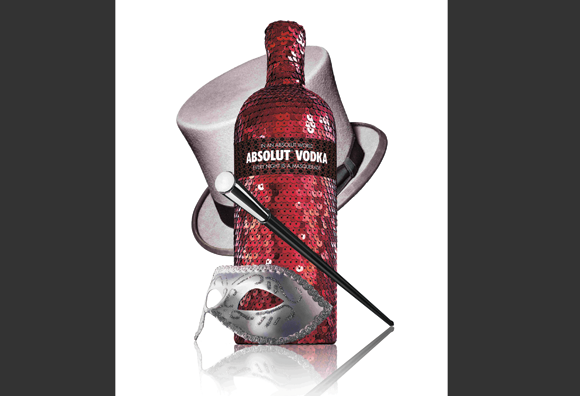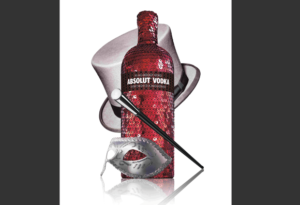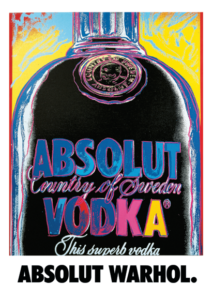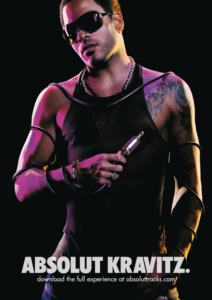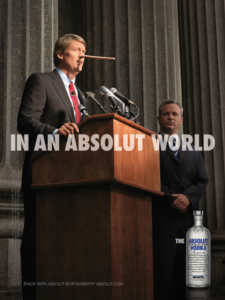How did it all start? What was the initial idea for Absolut’s ad campaigns?
Together with our advertising agency TBWA in New York, we decided to use the product as the hero of all advertising. The ads should express something complimentary about the product, and the intelligence of the consumer should never be underes-timated. The headlines were to consist of two words: „Absolut“ and one more.
The first advertisement was Absolut Perfection. To this day more than 1,000 ads have been produced, all with the basic idea of interpreting things from the Absolut perspective.
Did you conduct a lot of market research concerning the target audience back then?
At the end of the 1970s, just before the decision was made to launch Absolut Vodka in the US, a market research study was conducted, and the results were devastating. Everything about Absolut Vodka was wrong: The clear bottle disappeared at the back of the bar, Sweden was not known for vodka – vodka came from Russia. The bottle looked like a medicine bottle, and the name was misspelled: Absolut instead of Absolute.
Even the bottleneck was too short for bartenders to get a good grip on. It was difficult to find an importer willing to have a go at this strange new brand. The brand broke too many rules for this rather conventional market, but it quickly became a huge success.
After the bottle was established as a trademark of the campaign, how did you move on to new territories like incorporating lifestyle elements or the arts in the campaign?
Absolut was most successful among the creative crowd. Since 1981, Absolut Vodka has commented and paid tribute to contemporary culture. Absolut has a long standing passion for creativity and aims to enable and encourage creative connections among people. The Absolut brand’s commitment to the arts has always been based on mutual inspiration. Absolut began its involvement in the arts in 1985 with
Absolut Warhol. Since then, the creative nature of the brand has attracted some of the leading visionaries of our time and been a creative canvas for over 600 artists within creative disciplines such as art, technology, fashion, music and design.
How do you deal with the drastic changes that have afflicted the media over the last couple of years?
Absolut has always been an innovator in creative content and the use of media. The brand continues to be on the forefront of the world’s ever changing media landscape.
The basic concept has remained the same since the first ad was produced. But it was carried out in hundreds of variations. By the way, we have collaborated with the same advertising agency, TBWA, since the launch in 1979.
Challenging the status quo, being disruptive in the use of media has always been part of the brand’s DNA. Historically, when print was our main media delivering our campaign through print was done in various ways.
Was it difficult to establish the brand in Europe outside of Sweden? Are there any differences in the target audience or in the way to attract attention compared to the US?
Quality and high creativity are attractive to a certain group of people, no matter what country they are living and working in. Absolut has a universal appeal and aspirational quality that make it successful in almost every market it is introduced to.
The brand has grown organically across markets since its US launch and has continuously increased in sales. From 100,000 cases in 1979 to over 10 million cases in 2008. According to Impact’s estimates, Absolut Vodka is the fourth largest premium distilled spirit brand worldwide.
Are you still working together with magazine editors to produce the right ad for each magazine at least in the special interest area?
As the new campaign grows and evolves, the brand’s involvement and collaboration with the creative community and influencers will continue to grow and evolve for new audiences.
Why do you think is the long running campaign so successful? What are the challenges nowadays in the advertising business for an established brand like Absolut?
The classic Absolut „bottle“ campaign revolutionized advertising and the use of media, and created the premium vodka ca-tegory. Over 29 years and after 1,500 ads it has become one of the most iconic and effective campaigns in history. As an arbitrary of popular culture, Absolut commented and paid tribute to the cultural conversations of the consumers’ daily lives.
Its success came from an undeniable smartness, creativity and wit that was both inclusive and exclusive and uniquely Absolut. Everyone waited to see what the brand would do next.
Since 1979, consumers have changed. They want to interact, engage and participate in their brands. The media landscape has changed. Communication is less one way, more participatory. The new campaign, In an Absolut World, launched in 2007, is an evolution allowing Absolut to fully utilize media and engage audiences in bolder ways. Having invited artists and designers to give their view on the brand, Absolut continues to lead the conversation by also inviting its audiences – inspiring them to give their vision of an Absolut World.
How do you see the future of the brand and of the advertising business in general?
Marketing messages must provide more value for today’s audiences or they will simp-ly walk away from it. Everything a brand says and does must be treated as content that will be useful or entertaining to its audiences. Absolut continues to do this by sparking discussions and introducing its audiences to creative ideas and creative visionaries they may never have encountered on their own.
Do you have any favourite ad or series of ads?
My personal favourite is the Absolut Metropolis campaign – rather than collaborating with fashion designers, the brand turned to the streets where many designers take their inspiration from.
As opposed to teaming up with big name designers, Absolut worked with new talent to portray how urban personalities actually live the brand, by permitting them to express it in their own personal style. The individuals involved with Absolut Metropolis use their own identities, as an arena of creativity, to create a vibrant original style. Eleven of Tokyo’s most colourful individuals including local underground legend Pyuupiru express themselves through costumes in a new fashion project photo-graphed by Nadav Kander. Another one of my favourites is Absolut Machines. Early this year, Absolut explored what will happen when cutting-edge technology meets the creativity of art, music and design. To emphasize its deep commitment to the subject, Absolut turned to some of the greatest technology visionary teams of our time, and asked them to create The Absolut Machines. This resulted in two artificially creative and highly interactive music-making machines, as visually stunning as they are technologically pioneering.
The project marks the first collaboration between Absolut and cutting-edge visionaries from the world of technology. The Absolut Machines are designed by Dan Paluska and Jeff Lieberman, both with a background from MIT in Boston, and Teenage Engineering, a Swedish studio in the fields of media, art and technology.
Users from around the world interacted with the machines. Their musical input was processed by the machines, who responded with a unique musical composition, co-created by man and machine. The machines will immediately perform the songs, and their performances will be live-streamed at absolutmachines.com.
A not so well-known fact is that Absolut is a strong supporter of lesbian and gay rights movements.
Exactly. Absolut was one of the very first consumer brands to do so, with supportive relations to the LGBT community dating back to the early eighties. Over the last 25 years, Absolut has invested more than $20 million into the LGBT community, with some of those marketing dollars supporting organizations and events such as the GLAAD Media Awards, the 25th Anniversary of the rainbow flag and the Gay Games. Absolut also has supported various gay and lesbian community centers, film festivals and pride parades.


